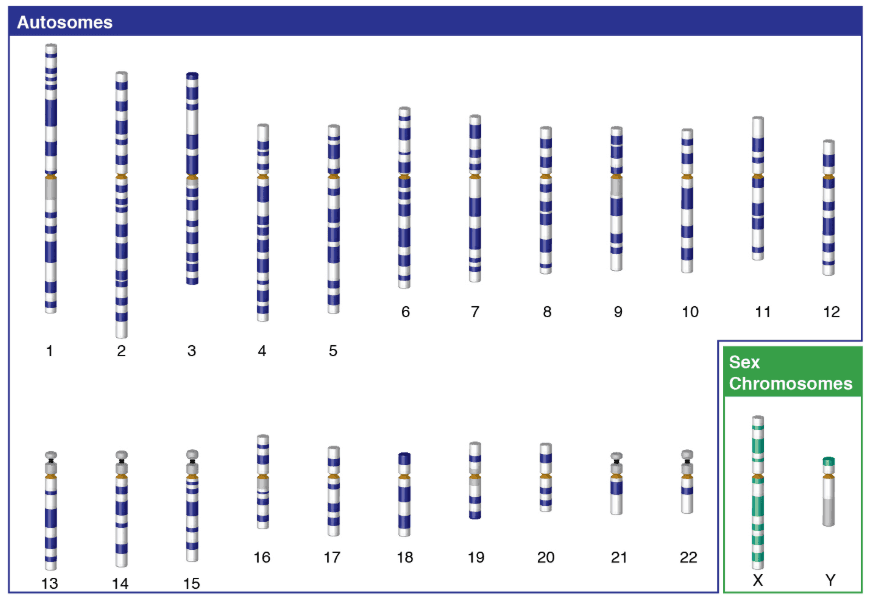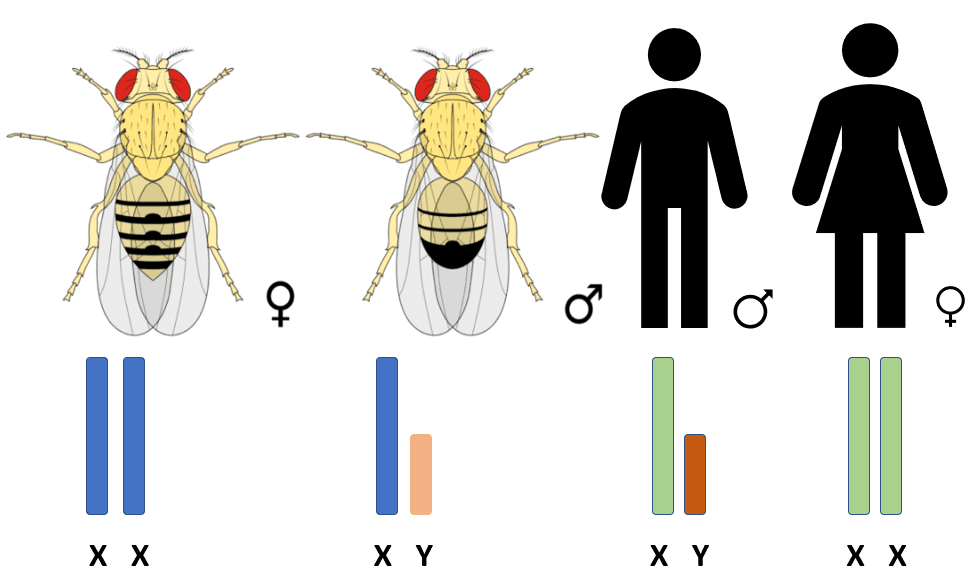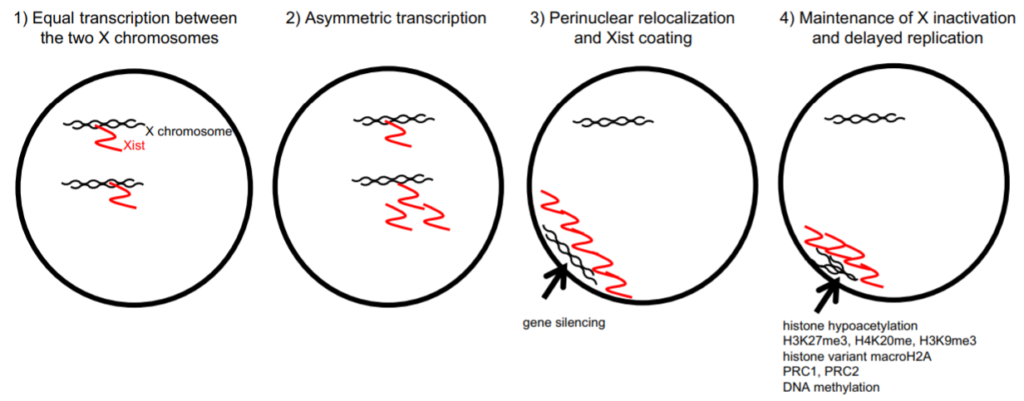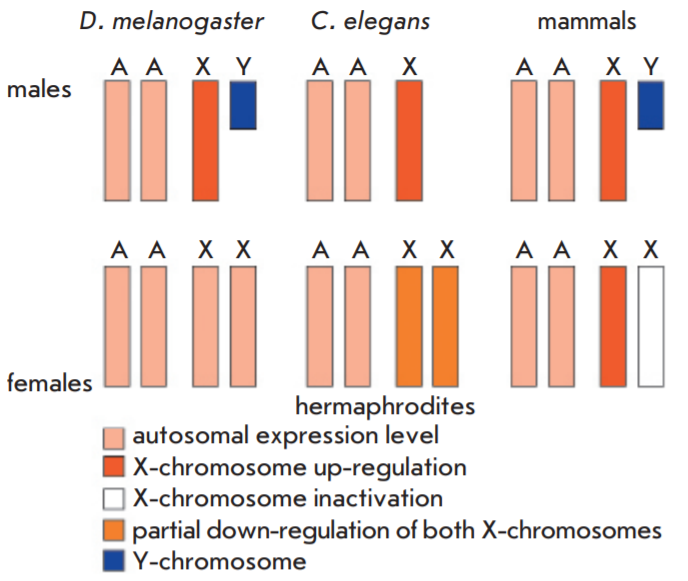Introduction
Chromosomes are thread-like structures, located in the nucleus, which carry hereditary information in the form of genes. Structurally, it is composed of ‘packaging proteins and DNA molecules’, and it is represented in different shapes and numbers which vary among different living organisms.
For example, bacteria have circular chromosomes, whereas organisms like humans and other animals have linear chromosomes (humans have linear chromosomes in the nucleus and circular chromosomes in mitochondria).
Similarly, the number of chromosomes also varies among different organisms:
Chromosomes are of two types: autosomes and sex chromosomes. This article is focused on the theory and facts of human sex chromosomes.
It includes every aspect of human sex chromosomes from the mechanism of sex determination and X-inactivation in humans to the sex chromosomes aneuploidy. It also provides a glimpse of how the mechanisms in humans differ from other organisms.
What are Sex chromosomes?
Ever wondered how you developed into a girl or a boy? Well, that is determined by the sex chromosomes of your parents.
Humans have a total of 23 pairs of chromosomes (two sets of chromosomes). One set of the chromosome is inherited from the mother and the other set from the father. Out of 23 pairs of chromosomes, 22 pairs are autosomes and 1 pair is sex chromosomes.
Autosomes function in the regulation of somatic characteristics of the individual (e.g. body weight, length of the body, etc.) whereas sex chromosomes are involved in the “sex determination” of the organisms and regulation of sex-linked traits.
In humans, sex is determined by two types of chromosomes, X and Y chromosomes. The X chromosome is three times larger than the Y chromosome. Moreover, it contains over 900 genes and the Y chromosome has only about 55 genes on it.

Figure: The illustration of the 23 pairs of chromosomes in humans (22 pairs autosomes and one pair sex chromosome)[6].
Source: https://www.genome.gov/genetics-glossary/Sex-Chromosome
How Were Sex Chromosomes Discovered?
Hermann Henking was the first to discover the X chromosome (in 1981). He named it the X element but he could not understand its role. In 1905, two scientists, Nettie Stevens and Edmund Beecher Wilson worked individually to study the role of sex chromosomes (on insects).
Stevens reported the presence of two large chromosomes in the beetle gonads (female), and one small and one large chromosome in the male sperm. She concluded that the small chromosomes carried by the sperm, determine the sex of the male[5].
Steven’s study was later supported by Wilson, that both large and small chromosomes are sex determinants and the small chromosome determines the maleness of an organism. He named the large chromosome “X” and the small one “Y”[5].
Later, scientists observed the absence of the small chromosome in wasps. It caused a dilemma, whether the presence or absence of the Y-chromosome is responsible for the maleness in organisms! Wilson resolved this by studying data from different labs. He concluded that two types of ‘sex determination systems’ exists among organisms.
How is Sex Determined in Humans? - Sex Determination System
Humans have an “XY system” of sex determination. The individual, having two X chromosomes (XX) develops into a female while the one with a pair of XY chromosomes will develop into a male.
Do You Know?
Other than the XY system of sex determination in humans, three other systems have also been studied by researchers in various other organisms, which include:- XO system: i.e. in grasshoppers. In this system, female grasshoppers have an identical pair of chromosomes (XX) while male grasshoppers have only a single X-chromosome.
- ZW system: i.e. in birds. In this system, female birds have a non-identical pair of chromosomes (ZW) and male birds have an identical pair of chromosomes (ZZ).
- Haplodiploid system: This is a very unique kind of system which is observed in honey bees. In this system, males develop from an unfertilized egg and so they are haploid (presence of half the number of total chromosomes or one set of chromosomes). Females (queen and worker bees) develop from the fertilized eggs so they are diploid (two sets of the chromosome). Thus, honey bee sex determination is dependent on egg fertilization.
In a few human cases, sex chromosome aneuploidy can also be observed. For example, an individual can be born with 47, XXY; 47, XYY; 47, XXX; and 45, X[4]– these kinds of chromosomal arrangements cause several abnormalities in the organisms.
But, an individual having a Y-chromosome (no matter how many X chromosomes are present) will always develop into a male. On the other hand, an individual without Y chromosomes will develop into a female.
Moreover, in females, one X chromosome is inherited from the mother and the other X from the father while in males X chromosome is always inherited from the mother[7].
Mechanism of Sex Determination
Genes are the key regulators of all the features of the organisms so their role in sex determination cannot be neglected. However, in a few other organisms, there are some other factors, other than sex chromosomes, that decide the sex of the organisms. For example, in European turtles, sex is determined by the temperature of the surroundings.
Genetic Mechanism of Sex Determination in Humans
The human embryo contains two types of duct, Mullerian duct, and Wolffian duct, in the seventh month of development. These ducts can develop a female or male reproductive tract. But, these ducts can not do it alone (by themselves). So how does it happen?
The SRY (Sex determining Region Y) gene, present on the short arm of the Y chromosome, encodes the Testes Determining Factor (TDF) which induces the formation of the testes.
The testis produces two types of hormone, anti-mullerian hormone (produced from Sertoli cells of the testis), and testosterone (from Leydig cells which are induced by Sertoli cells)[4].
The testosterone and its derivative dihydrotestosterone further induce the formation of organs of the male reproductive system whereas the anti-mullerian hormone (AMH) suppresses the development of the female reproductive tract.
When there is an absence of the Y chromosomes (in females), the SRY gene is not expressed and the pathway of ovary formation is activated. The ovary then secretes the female sex hormone, the estrogen, which activates the Mullerian duct that leads to the development of female reproductive organs (uterus, cervix, and oviducts)[4].
Do You Know?
Drosophila melanogaster also involves an XY system of sex determination like humans! However, unlike human sex determination, the presence or absence of the Y chromosome does not determine the maleness of the organism. Their sex is mainly determined by the X chromosome to autosome ratio (X:A).
Figure: An illustration of a similar sex-determination system in humans and Drosophila melanogaster.
When the X:A ratio is ≥ 1.0 (1X:1A, 2X:2A, 3X:3A, and 3A:2A) then the fly will develop into a female[3]. On the other hand, when the ratio of X:A is ≤ 0.5, then a male will be developed.
Dosage Compensation and Formation of Barr Bodies
An important fact about sex chromosomes is that the X chromosome is larger than the Y chromosome in size and contains 1000 genes more than the Y chromosome.
You know that a female has two X chromosomes and a male has only one. So, it is expected to see significant differences in gene expression, in both the sexes. But, the picture is quite the opposite! So, the question arises, “why is this difference not observed?”
The answer to the above question is “dosage compensation”.
What is Dosage Compensation?
When one sex of organism contains two dosages of one sex chromosome and the other sex has only one, then the difference in the expression level is achieved by a mechanism called dosage compensation. Variant mechanisms of dosage compensation, of X-linked genes, are evolved by different organisms.
Genetic Mechanism of Dosage Compensation in Humans
In Humans (and other mammals as well), dosage compensation is achieved by the inactivation of the majority of genes, localized on one of the two X chromosomes in females, during early development. The inactivation of the X chromosome is a random process, either maternal or paternal X-chromosome (in female) is randomly inactivated.
The key gene that is involved in the process of the X-inactivation gene is the Xist (X-inactive-specific transcript) gene, present in the Xic region on the X chromosome[2]. The expression of Xist is asymmetrical in two X chromosomes.
The chromosomes having a higher expression of genes produce higher transcripts of Xist RNA[2]. The RNA, with some binding proteins, coats one of the two X chromosomes along its length and causes repression.
The inactivated X chromosome structurally becomes small, dense, and highly compact (condensed chromatin). This structure is called “Barr bodies”, named after its discoverer, Murray Barr. The feature of the presence and absence of Barr bodies is used in labs for the sex determination of the individual.

Figure: The random X chromosome inactivation in the mouse during embryogenesis[2].
Source: DOI:10.1016/bs.ircmb.2015.03.001.
Do You Know?
Not all organisms follow a similar mechanism of dosage compensation. Researchers have found two other mechanisms of dosage compensation in other organisms which completely differ from humans!

Figure: Illustration of difference in the mechanisms of dosage compensation in different organisms[1].
- In melanogaster, the mechanism involves the up-regulation of X-linked genes.
- In elegans, the mechanism involves partial down-regulation of both X-chromosomes that occur in females and up-regulation of one X-chromosome in males.
- In mammals (e.g. humans), dosage compensation is done by inactivating one of the two X-chromosomes in females.
Sex Chromosome Aneuploidy
Aneuploidy is a condition of the presence of less than or more than the normal number of chromosomes. Sex chromosome aneuploidy is a condition in which the number of sex chromosomes alters in an organism.
For example, normally an organism has XX (in females) and XY (in males) sex chromosomes while during aneuploidy condition he/she can have XXX, XXY, XYY, XO, etc. type of chromosomal arrangements. The most common cause of sex chromosome aneuploidy is non-disjunction during the process of cell division (meiosis).
The aneuploidy condition leads to several abnormalities in the organism. A few examples of diseases[9] caused due to sex chromosome aneuploidy are given below:
1. Turner’s Syndrome
- It is a genetic disease that occurs due to the absence of the Y chromosome from the male (45, X).
- It is also referred to as the monosomy of X.
- An individual with this arrangement (45, X) develops into a female.
- The frequency of occurrence of this disease is 1:3000[9].
- This condition causes several developmental abnormalities in the individual such as infertility, short stature, heart problems, vision defect, kidney malformation, and mental problems[9].
2. Klinefelter’s Syndrome
- In this condition, the individual has 47, XXY or 47, XY/XXY mosaic arrangements of chromosomes.
- The individual with this condition develops into a male.
- The frequency of occurrence of this disease is 1:6000[9].
- This genetic disease causes several abnormalities in the individual which include: infertility, hypogonadism (low levels of testosterone in males), osteoporosis, lung disorders, breast cancer, autoimmune diseases, and heart problems[9].
3. Androgen Insensitivity Syndrome
- It is an X-linked recessive disorder. In this condition, a male despite having the XY arrangement of chromosomes shows female phenotypic characters (breast development and female genitalia).
- This disorder occurs due to the mutation in the AR gene which makes an individual unresponsive to male hormones testosterone yet he can respond to estrogens.
- The frequency of occurrence of the diseases is 2-5 in 100,000 people[8].
- The two types of Androgen insensitivity syndrome are: Complete androgen insensitivity (the body cannot respond to the androgens at all) and partial androgen insensitivity (the body is partially sensitive to the effects of androgens). Males affected with this syndrome become infertile in both cases[8].
4. XYY Syndrome
- This is a genetic condition in which the male has an extra copy of Y chromosomes in all cells or some cells (mosaicism).
- The affected individual has male characteristics.
- The frequency of occurrence of the disease is 1 in 1,000 newborns[8].
- The characteristics of the affected male include: taller than average, learning disabilities, delayed development of motor skills, hand tremors, seizures, depression, autism spectrum disorder (impaired social and communication skills), and asthma.
- The phenotype of the affected male may involve macrocephaly (large head), flat feet, curved fingers, and widely spaced eyes[8].
- Most males in this condition can produce normal levels of testosterone and have normal sexual organs (fertile)[8].
5. XXX females
- This condition arises due to the presence of an extra X chromosome in each cell (47, XXX) or some cells (47, XX/XXX-mosaicism) of females.
- The frequency of occurrence of this disease is 1 in 1,000 newborn girls[8].
- The affected female shows characteristics like learning disabilities, problems in motor skills, hypotonia, kidney abnormalities, delayed development of language skills, and seizures.
Conclusion
Sex chromosomes are involved in the sex determination of organisms and the regulation of sex-linked traits. Various studies have also shown the involvement of other factors in the sex determination of other organisms.
However, humans have X and Y sex chromosomes, which are the only determining factors of the sex of a newborn human.
The presence and/or absence of the Y chromosome determine the maleness of the organism, while the inequality of the gene expression between males and females is balanced by the mechanism of X-inactivation.
If the normal number of sex chromosomes (XX or XY) is altered in an individual, it leads to several abnormalities in the affected human. Further research in this area will add more understanding to the sex linked genes, their inheritance, and the mechanism behind sex determination.
References:
- Dementyeva V. E. and Zakian M. S. (2010). Dosage Compensation of Sex Chromosome Genes in Eukaryotes. Acta Naturae, 2(4).
- Gay, S., & Foiani, M. (2015). Nuclear Envelope and Chromatin, Lock and Key of Genome Integrity. International Review of Cell and Molecular Biology, 267–330. DOI:10.1016/bs.ircmb.2015.03.001.
- Gilbert SF. (2000). Chromosomal Sex Determination in Drosophila. Developmental Biology, (6th ed.), Sunderland (MA): Sinauer Associates.
- Hake, L. & O’Connor, C. (2008) Genetic mechanisms of sex determination. Nature Education 1(1), 25.
- Miko, I. (2008) Sex chromosomes and sex determination. Nature Education 1(1), 108.
- https://www.genome.gov/genetics-glossary/Sex-Chromosome
- https://www.genome.gov/about-genomics/fact-sheets/X-Chromosome-facts
- https://ghr.nlm.nih.gov/condition/triple-x-syndrome#genes
- https://www.who.int/genomics/gender/en/index1.html
